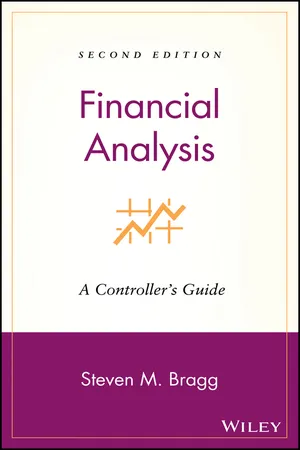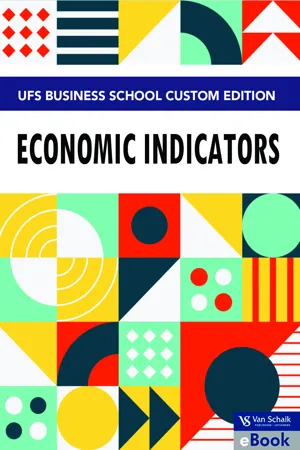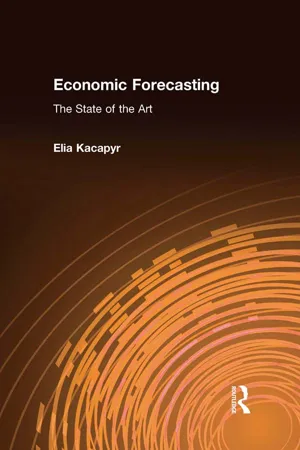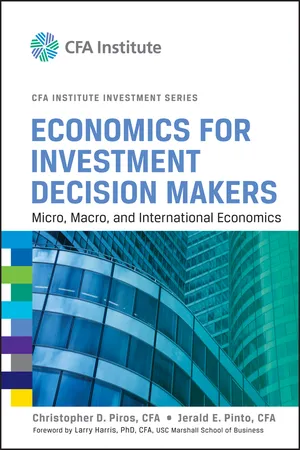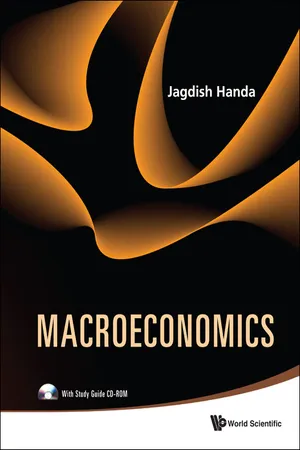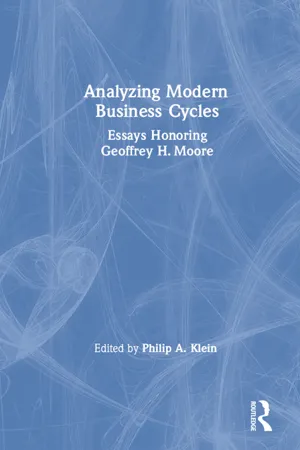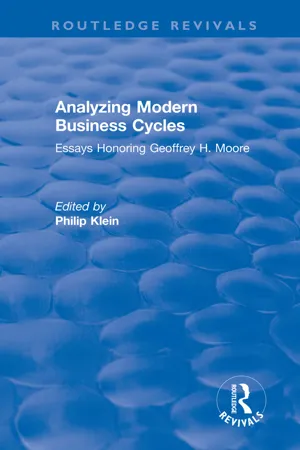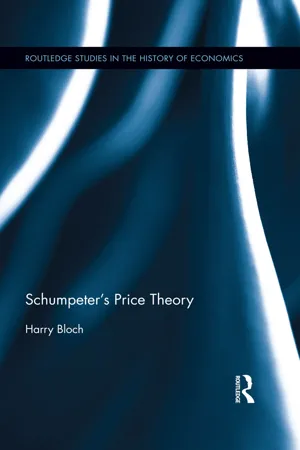Economics
Forecasting Business Cycles
Forecasting business cycles involves using statistical and economic indicators to predict the fluctuations in economic activity over time. This process helps businesses, policymakers, and investors make informed decisions by anticipating changes in the economy. Forecasting business cycles typically involves analyzing trends in GDP, employment, consumer spending, and other key economic variables to identify patterns and potential turning points in the business cycle.
Written by Perlego with AI-assistance
Related key terms
Related key terms
1 of 4
Related key terms
1 of 3
10 Key excerpts on "Forecasting Business Cycles"
- eBook - ePub
Financial Analysis
A Controller's Guide
- Steven M. Bragg(Author)
- 2012(Publication Date)
- Wiley(Publisher)
This chapter explained how the breakeven analysis works, and gradually built on the basic model by adding explanations and discussions of ways in which the fixed-cost, variable-cost, and volume components of the calculation can be modified to arrive at a variety of real-world breakeven scenarios, several of which were covered in the preceding section. A brief perusal of the breakeven case studies makes it apparent that paying continual attention to this form of analysis in the daily running of a business will yield a better understanding of how and at what volume level a company can be expected to turn a profit.Passage contains an image
Chapter 10
Business Cycle Forecasting
A company’s planning and operations can be severely affected by a significant change in the business environment, such as can be caused by the vagaries of a business cycle. This section describes the nature of a business cycle and how it impacts a corporation. Then, the various methods currently used for Forecasting Business Cycles are noted, as well as several theories regarding why business cycles occur. Finally, the areas in which a controller can provide meaningful input to company management regarding the impact of business cycles on a company’s specific lines of business are explored.NATURE OF THE BUSINESS CYCLE
A business cycle is a recurring series of expansions and contractions, involving and driven by a vast number of economic variables, that manifests itself as changes in the level of income, production, and employment. As will be described in the next section, these swings can have a profound impact on a company. A business cycle tends to be long-term in nature, and is very difficult to predict in terms of length or intensity. It is driven by so many variables, most of which interact with each other, that it is excruciatingly difficult to determine the exact causes of previous cycles and the timing of the next one based on those variables.Although the exact causes of the business cycle are difficult to discern (see the Theories behind Business Cycle Forecasting section), essentially two types of variables cause business cycle changes to occur. The first is an exogenous variable . This variable affects the economic system, though it is not an integral component of the system. A bad rainy season will affect the crop yields in the farming community, for example, which in turn reduces the amount of purchases by farmers for the next season’s crop, which in turn affects the activity of the suppliers of those purchases, and so on. Another exogenous variable is a war, which can wreak enough destruction to entirely shatter an economy. These types of variables can, to some extent, be called “acts of God.” The other type of variable is the endogenous variable - eBook - ePub
Always a Winner
Finding Your Competitive Advantage in an Up and Down Economy
- Peter Navarro(Author)
- 2009(Publication Date)
- Wiley(Publisher)
STEP IBECOMING YOUR OWN ECONOMIC FORECASTERPassage contains an image
CHAPTER 5How (and Why) the Business Cycle CyclesBets on macroeconomic direction are among the biggest enterprises make. . . . Ignoring the macroeconomy and assuming that things will continue more or less as they are doesn’t mean a big bet hasn’t been made.—Professor John S. McCallumBefore learning how to become your own economic forecaster, first it’s useful to learn about both how and why the business cycle moves and the various forces that can trigger a recession. A useful starting point for this discussion is to introduce the most powerful forecasting tool featured in this book: the GDP forecasting equation.GDP stands for “gross domestic product,” and the economic growth of any nation is measured by its GDP. As a practical matter, GDP growth is driven by only four components: consumption, business investment, net exports, and government spending. As Chapter 6 explains, by using a select set of leading economic indicators and reports to track each of these major GDP components, any business executive can develop a very keen sense of the movements and key turning points of the business cycle. For now, however, the GDP equation can help us understand how to chart the business cycle and how the cycle moves through its different phases.GDP CHANGES CHART THE BUSINESS CYCLE
When economists want to chart the path of the business cycle, they use percentage changes in the real, inflation-adjusted GDP to plot the cycle’s major points over time. This technique is illustrated in Exhibit 5.1 . Note that the stylized business cycle in the exhibit looks like a roller coaster. It illustrates that every business cycle sequentially moves through alternating expansionary and contractionary phases punctuated by key boom and bust turning points.In plotting the business cycle, economists use the “real” (inflation-adjusted) GDP because it is the best measure of actual bricks-and-mortar growth. Adjusting for inflation solves the problem of having to compare one economy with a 5% GDP growth rate and zero inflation with another economy with a 10% GDP growth rate and a 10% rate of inflation. If inflation were not taken out of the GDP equation, it would look like the first economy was growing at half the rate of the second economy when, in reality, the second economy is not growing in real terms at all. - eBook - ePub
- P Mohr, D Yu, S Adendorff(Authors)
- 2020(Publication Date)
- Van Schaik Publishers(Publisher)
674Business cycles
The first question people usually ask about the economy is: “What is happening to the economy?” or “How is the economy performing?” This is usually followed by “What is going to happen?”, “What are the country’s economic prospects?” or “Are we going to experience a recession?” All these questions relate to a phenomenon called the business cycle . In this chapter various aspects of the business cycle are discussed, including possible ways of forecasting economic activity.4.1 DEFINITIONS
Economic growth (or decline) does not occur smoothly. Periods of rapid growth or expansion are invariably followed by periods of lower growth or decline. The business cycle refers to the fluctuations in the overall level or pace of economic activity. Sometimes also called the trade cycle , it can be defined as the pattern of expansion (recovery) and contraction (recession) in economic activity relative to its long-term trend. One complete cycle, which usually lasts a number of years, consists of four elements: a trough , an upswing or expansion (often called a boom ), a peak , and a downswing or contraction (often called a recession ). The different elements of the business cycle are illustrated in Figure 4-1 .A full cycle in aggregate economic activity is called a reference cycle . Thus, when people want to know whether the economy is in an expansionary phase or in a recession, they are inquiring into the position of the economy in terms of the reference cycle. Apart from the aggregate movement in economic activity, each individual time series (eg the physical value of agricultural production, the number of new motorcars sold, real merchandise imports) exhibits a cyclical pattern. In 68 contrast to the reference cycle, a specific cycle - eBook - ePub
Economic Forecasting: The State of the Art
The State of the Art
- Elia Xacapyr(Author)
- 2016(Publication Date)
- Routledge(Publisher)
1 Introduction to Economie ForecastingDespite our years of learning and our efforts at education, we still find our patients and clients longing for relief and turning, with distressing frequency, to today’s equivalent of snake oil and witchcraft.—Paul Volker, 1993There is nothing novel about making economic projections. By 1930, Garfield Cox’s book, An Appraisal of American Business Forecasts , was in its second edition. Almost seventy years later Cox’s title is still apt. Before 1940, however, there was no distinction between “business” forecasts and “economic” forecasts. Even today, some professionals see no need to differentiate between the two. Yet almost everyone in the field understands that business forecasting primarily appertains to predictions about the performance of individual firms or industries. Economic forecasting, on the other hand, is associated with making predictions about the economy of a region or of the entire nation. The distinction between the two types of forecasting is not crisp because they share some of the same techniques. One often finds the same persons and establishments practicing in both fields.To complicate matters further, there is much discussion about the business cycle—the ups and downs in overall economic activity. The term “business cycle,” however, is a throwback to before World War II. To conform with the distinction between business and economic forecasting, the term “economic cycle” would be more appropriate than “business” cycle. The traditional terminology is too ingrained to change.This book concentrates on economic forecasting. How do forecasters produce predictions about interest rates, employment, prices, production levels, and the like? What are the intricacies involved in these sorts of projections and how accurate are they? In short, the reader will be introduced to the art of economic forecasting.The Value of Economic Forecasts
Some skeptics would assert that economic forecasts are of very little value. Consider the epigram from the noted economist John Kenneth Galbraith: “We have two sorts of forecasters: Those who don’t know—and those who don’t know they don’t know.” It is impossible to deny the bravado of economic forecasters, but it would be unfair to call them cavalier. Most are keenly aware of the precariousness of their prognostications. It is just that these forecasters are not discouraged by the difficulty of the task at hand. - eBook - ePub
Economics for Investment Decision Makers
Micro, Macro, and International Economics
- Christopher D. Piros, Jerald E. Pinto(Authors)
- 2013(Publication Date)
- Wiley(Publisher)
Whereas the chapter on national income accounting and growth focused on long-term economic growth and the factors that help foster it, this chapter addresses short-term movements in economic activity. Some of the factors causing such short-term movements are the same as those causing economic growth, such as changes in population, technology, and capital. However, other factors, such as money and inflation, are more specific to short-term fluctuations.This chapter is organized as follows. Section 2 describes the business cycle and its phases, explaining the behaviors of businesses and households that typically characterize phases and transitions between phases. Section 3 provides an introduction to business cycle theory, in particular how different economic schools of thought interpret the business cycle and their recommendations with respect to it. Section 4 introduces basic concepts concerning unemployment and inflation, two important economic policy concerns that are sensitive to the business cycle. Section 5 discusses variables that fluctuate in predictable time relationships with the economy, focusing on variables whose movements have value in predicting the future course of the economy. A summary and practice problems conclude the chapter.2. OVERVIEW OF THE BUSINESS CYCLE
Burns and Mitchell (1946) define the business cycle as follows:Business cycles are a type of fluctuation found in the aggregate economic activity of nations that organize their work mainly in business enterprises: a cycle consists of expansions occurring at about the same time in many economic activities, followed by similarly general recessions, contractions, and revivals which merge into the expansion phase of the next cycle; this sequence of events is recurrent but not periodic; in duration, business cycles vary from more than one year to 10 or 12 years.This long definition is rich with important insights. First, business cycles are typical of economies that rely mainly on business enterprises—therefore, not agrarian societies or centrally planned economies. Second, a cycle has an expected sequence of phases representing alternation between expansion and contraction. Third, such phases occur at about the same time throughout the economy—that is, not just in agriculture or not just in tourism but in almost all sectors. Fourth, cycles are recurrent (i.e., they happen again and again over time) but not periodic (i.e., they do not all have the exact same intensity and duration). Finally, cycles typically last between one and 12 years. - eBook - ePub
Macroeconomics
(With Study Guide CD-ROM)
- Jagdish Handa(Author)
- 2010(Publication Date)
- WSPC(Publisher)
CHAPTER 16 Business Cycles, Crises, and The International Transmission of Economic ActivityBusiness cycles are periodic fluctuations in economic activity. While the magnitudes of almost all economic variables fluctuate over time, the most significant variables for defining the business cycle are fluctuations in output and employment. The business cycle consists of a trough, upturn, peak, and downturn — followed by a trough and so on. In a growing economy, recessions tend to have a much shorter duration — usually of about six quarters to two years — than booms, which are often longer than six years.Macroeconomics investigates the causes of business cycles and whether monetary and fiscal policies can eliminate or moderate business cycle fluctuationsBusiness cycles are periodic fluctuations in economic activity. To describe a typical business cycle, we can start with its phase when economic activity is increasing. This upturn/expansion in economic activity culminates in a peak. The peak is followed by a downturn/contraction in economic activity. The downturn reaches a bottom, which is called the trough. The trough is a turning point for economic activity, which then starts a new upturn, which becomes the beginning of a new cycle. Therefore, the business cycle has four phases: upturn/expansion, peak, downturn/contraction, and trough. Note that the description of the business cycle could have been given starting with any one of these phases. The peak and the trough are called the ‘turning points’ of economic activity. The duration of a business cycle can be measured from one peak to the next one or from a trough to the next one.Business cycles can be defined in two different ways: 1. They can be defined in terms of absolute movements in economic activity. To illustrate, under this definition, the downturn would be a decrease in output and employment.2. For a growing economy, it can be defined as the movement around the trend level of economic activity. In this case, the downturn would be a decline in the growth rates of output and employment from their trend levels, even if there is no absolute decline in these variables. - eBook - ePub
- (Author)
- 2023(Publication Date)
- Wiley(Publisher)
In the lessons that follow, we describe credit cycles, introduce several theories of business cycles, and explain how different economic schools of thought interpret the business cycle and their recommendations with respect to it. We also discuss variables that demonstrate predictable relationships with the economy, focusing on those whose movements have value in predicting the future course of the economy. We then proceed to explain measures and features of unemployment and inflation.Learning Module Overview
- Business cycles are recurrent expansions and contractions in economic activity affecting broad segments of the economy.
- Classical cycle refers to fluctuations in the level of economic activity (e.g., measured by GDP in volume terms).
- Growth cycle refers to fluctuations in economic activity around the long-term potential or trend growth level.
- Growth rate cycle refers to fluctuations in the growth rate of economic activity (e.g., GDP growth rate).
- The overall business cycle can be split into four phases: recovery, expansion, slowdown, and contraction.
- In the recovery phase of the business cycle, the economy is going through the “trough” of the cycle, where actual output is at its lowest level relative to potential output.
-
In the expansion phase of the business cycle, output increases, and the rate of growth is above average. Actual output rises above potential output, and the economy enters the so-called boom phase.
-
In the slowdown phase of the business cycle, output reaches its highest level relative to potential output (i.e., the largest positive output gap). The growth rate begins to slow relative to potential output growth, and the positive output gap begins to narrow.
- eBook - ePub
Analysing Modern Business Cycles
Essays Honoring Geoffrey H.Moore
- Philip A. Klein(Author)
- 2019(Publication Date)
- Routledge(Publisher)
We must face the question of how helpful this practice is for government and business economists in their respective roles of advising decision makers. While it seems reasonable to proceed (as a first approximation) on the theoretical basis that there are close family likenesses from one cycle to another, it would seem to be stretching it too far and could be very misleading for both theoretical and policy purposes to view business cycles as “all alike” to the extent that Lucas seems to suggest. Furthermore, variations in duration (which are generally recognized) are themselves likely to contribute to, and to be an effect of, variations in the character and qualitative behavior of co-movements of series during upswings (for instance, whether or not a full boom is experienced) and downswings (for instance, whether a growth slowdown leads to a classical recession). Certainly, knowledge of previous cycles, as provided by the indicator approach, can be very instructive in monitoring the current state of the economy and forecasting the likely course of events (Moore, ed., 1961; Moore and Klein 1977; Moore 1978, 1980a ch. 5 and part III, 1983 ch. 6 and part III; Boehm and Moore 1982, 1984; Klein and Moore 1985; Boehm 1987a, 1987b; CIBCR 1988b, 1988c; Central Statistical Office 1988; Westpac-Melbourne Institute 1988). This knowledge should also help to improve business cycle theory or to check its relevance as an aid in forecasting.If business cycles were as typical and alike from one to the next, economic forecasting should be much easier and have a much better track record than, in fact, it has: witness the indecision and diversity among economic forecasters over the likely course of the U.S. economy during 1979.8 With the advantage of hindsight and subsequent statistical evidence, we now know that a growth slowdown began in the United States in December 1978, but there remained considerable uncertainty (with a number of erroneous forecasts meantime) as to whether a classical downturn might occur. In the event, a classical peak was reached in January 1980 (Table 3.1 ).Despite the persistence of the short (growth) cycle as the main business cycle, the considerable variability in amplitude and duration from one cycle to another is clearly demonstrated in comparisons that have been made of individual cycles (Boehm and Defris 1977, 1982; Moore 1980b; Boehm and Moore 1982; DeLong and Summers 1986b; Zarnowitz and Moore 1986). The uncertainties about the course of activity apply especially at turning points and usually more so at the lower turning point, as long recognized, and pointed out by Matthews (1959, ch. 9 and 10), and as experienced by Australia “during the years 1975 to 1979 [when] there was considerable ‘on and off’ speculation about imminent recoveries in the economy” (Boehm and Defris 1982, 66). Moreover, the uncertainty regarding the course of economic activity has considerable significance for the rational expectation thesis of a limited role for economic policy, as discussed below. - eBook - ePub
Analyzing Modern Business Cycles
Essays Honoring
- Philip Klein(Author)
- 2017(Publication Date)
- Routledge(Publisher)
IIAnalyzing Business Cycles TodayPassage contains an image
3 Understanding Business Cycles Today: A Critical Review of Theory and Fact
Ernst A. BoehmThis paper critically reviews aspects of earlier leading business cycle theories and recent new developments, notably in the United States. The review is made especially in the light of the empirical evidence on business cycles. Some important recent improvements in our knowledge of the facts about business cycles, to which Dr. Geoffrey H. Moore has made a major contribution,1 appear to have been unjustifiably neglected in certain recent theories. The silence on these empirical findings raises questions about the relevance and usefulness to policy makers of these theoretical developments for the purpose of understanding business cycles today. The recent theoretical developments have centered largely around the subject of rational expectations, which itself has created a great deal of interest in economic theory in general since the early 1970s. Special attention is paid to the recent writings on business cycles stimulated by Robert E. Lucas, one of the leaders of the rational expectations school.There are four main general conclusions of this review. First, for theoretical and policy purposes, it is necessary to treat each business cycle as an individual. It is important to do so since each cycle varies from one to the next in respect to amplitude and duration; and each varies in the timing and nature of the changes of the co-movements of key variables, which contribute to the variations in amplitude and duration. Nevertheless, one is justified in studying business cycles as a group since "each cycle in some important ways in its decomposition into sectors and in the aggregate bears a close 'family likeness' to earlier cycles" (Boehm and Moore 1984, 35; see also Hicks 1950, 2). - eBook - ePub
- Harry Bloch(Author)
- 2017(Publication Date)
- Routledge(Publisher)
Business cycle theory and statistical methodsMainstream economics generally treats business cycles as arising from external shocks to the economy. These shocks disturb equilibrium, but only temporarily, as markets adjust to the shocks through a self-equilibrating process. For Schum-peter, business cycles are not aberrations, but rather an inherent part of the process of economic evolution associated with the introduction and absorption of innovations. Innovations lead to booms as entrepreneurs compete for means of production, such that, ‘The recurring periods of prosperity of the cyclical movement are the form progress takes in capitalistic society ’ (Schumpeter, 1927, p. 30, italics in the original). Recessions, in turn, are part of the process of adjustment to structural change required by the innovations, as old ways of doing things are replaced by the new.Schumpeter’s theory of the business cycle is an essential component of his theory of economic development starting from the first edition of Theorie der wirtschaftlichen Entwicklung (Schumpeter, 1926 [1912]), the precursor to the edition used for the English translation in the Theory of Economic Development (TED ) (Schumpeter, 1961 [1934]). During the period from the mid-1920s to the mid-1930s, Schumpeter references this theory in a number of journal articles, both contrasting it to the contemporaneous theories of others (as in Schumpeter, 1927, 1930) and using it as the basis for explaining the unevenness of growth under capitalism (as in Schumpeter, 1928, 1935). In the process, he puts forward a number of arguments about the necessity of integrating theory, statistics and historical analysis to achieve a full understanding of business cycles.The culmination of Schumpeter’s research on business cycles is the two-volume Business Cycles (BC) , published in 1939. While the discussion of business cycles appears in the last chapter of TED , in BC the cyclical aspect of development takes centre stage. There is an extended discussion of each of the four cycle phases, prosperity, recession, depression and recovery, along with a discussion of a multiplicity of cycles of different lengths overlapping each other. BC also contains a discussion of the application of statistical method to the interpretation of cycles and trend in time-series data. Finally, the bulk of BC
Index pages curate the most relevant extracts from our library of academic textbooks. They’ve been created using an in-house natural language model (NLM), each adding context and meaning to key research topics.
Explore more topic indexes
Explore more topic indexes
1 of 6
Explore more topic indexes
1 of 4
